Houston Is the New Capital Of Southern Cool
A few years ago, Matthew Odam was driving from Austin, Texas, where he's the restaurant critic at the Austin American-Statesman, to Houston, where he was raised. He had a passenger: a friend of a friend who was moving back to Houston after spending some time kicking around the capital, working music festivals, picking up shifts at a juice bar, and so on. He was a young African-American kid, maybe 21 but probably even younger, and kind of a beautiful art freak. He wore a black T-shirt with some kind of disembodied anime head on it and a spacey expression. He told Odam that he “dabbled in the occult.”
“At the time, having grown up in Houston in kind of a bubble, I was pretty skeptical about the city,” Odam says. So Odam asked the kid in the black T-shirt why he'd be moving there from someplace as verifiably and undeniably hip as Austin. The kid shrugged. Austin, he said, was a white monoculture of hipsters, yuppies, and techies. (Odam was telling me this story in a Japanese-fusion spot in East Austin, which made it easy to visualize said culture.) In Houston, the kid said, things were happening.
They were already driving through the city's periphery, which hardly meant they were near their destination. Harris County, made up of Houston and its suburbs, is 1,777 square miles, which is bigger than Rhode Island. “Where do you want to get dropped off?” Odam asked. The kid directed him to a spot nearby the park outside the main building of the Menil Collection, the art museum tucked into the Montrose neighborhood. “He told me all these kids were down there, hanging out in the park, dropping acid and making art,” Odam recalls. “Later, he was heading downtown to a club that was something out of Stefon. Like, ‘a midget working the door, transients as bartenders...’ ” Watching the kid walk off across the lawn, Odam considered: In Austin, everybody he knew would be fighting to get on the guest list for that club; the kids in the park would be pimping their Instagram accounts; the whole scene would be born, oversubscribed, and spent before it even happened.
He gripped the wheel and considered the unspeakable: “Was Houston cooler than Austin? Really?”
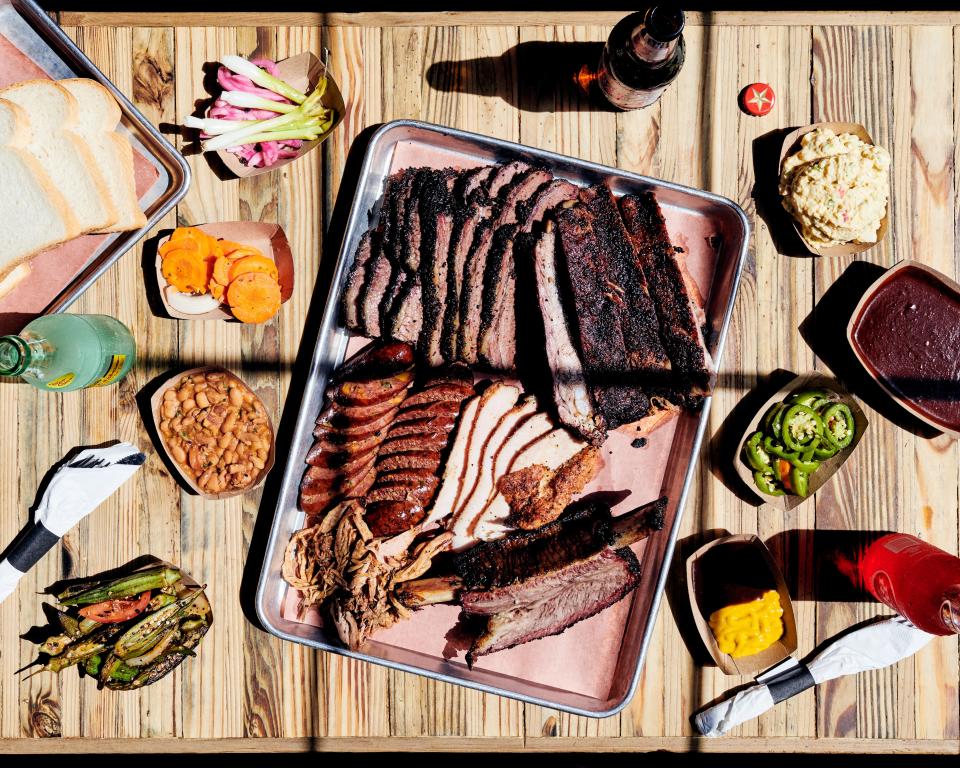
A smoky barbecue platter at The Pit Room.
Perhaps it's unseemly to begin with such a comparison. Houston is America's fourth-largest city, an international metropolis of great institutions and great wealth. It has professional sports teams; it has operas and ballets. Why compare it to a city that is half the size and a fraction as diverse?
But Austin, as Lawrence Wright points out in his book God Save Texas, is the Texas city that is permissible for those who live outside Texas: urbane, hip, progressive, and Texan in all the romantic, right ways (swaggering, wild, western) without so many of the wrong ones (conservative, provincial, big-haired). Also, Austin is unimpeachably cool—even if Austinites will spend half of any conversation bemoaning how much less cool it is now than at some point in the past, usually, by coincidence, the point at which they arrived.
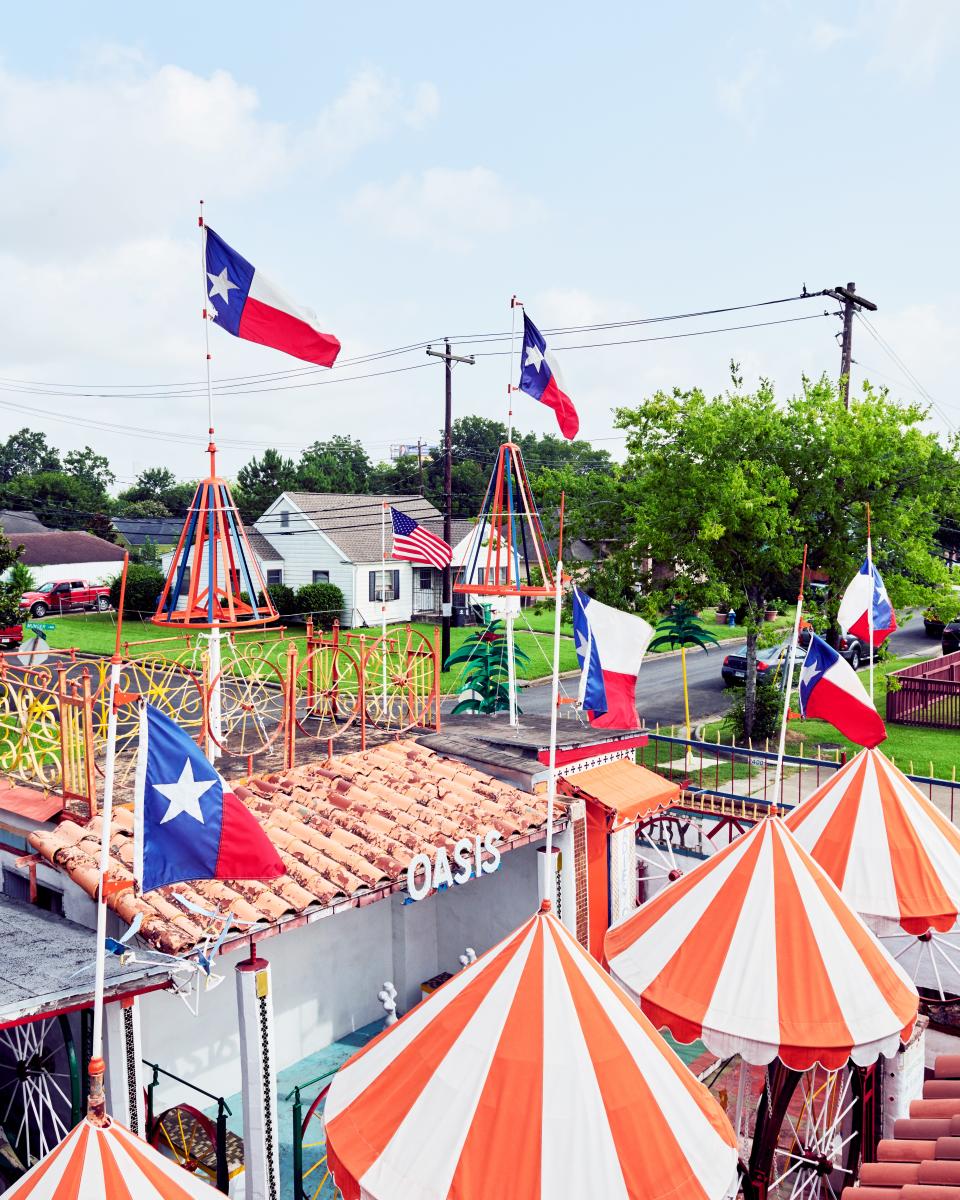
The temple of outsider art was built over several decades and remains a must-visit.
Houston, on the other hand, has remained for many—including plenty of people who were raised there—a kind of empty image. There's NASA. There's oil. There's the Galleria—the 2.4-million-square-foot shopping mall that is practically its own city-state. Beyond that, not much: a sterile, sun-blasted, multi-laned landscape of concrete, strip malls, and glass, the very vision of air-conditioned American anomie. When the cry went out, on T-shirts and bumper stickers, to KEEP AUSTIN WEIRD, part of the implicit message was to keep Austin not like Houston.
Then, sometime over the past five or six years, things started to change. As somebody who writes about food, I could hardly miss it. With its mix of exploding immigrant communities and ambitious, sophisticated variations on upscale dining, Houston had decisively shrugged off its reputation as a city of steak houses and chains to become increasingly mentioned as one of the nation's great restaurant cities. In these pages, David Chang called Houston the next food capital of America. This year, it earned two spots on my annual list of Best New Restaurants, a distinction shared only with New York City and Los Angeles.
And as stories like Odam's showed, there were signs of more afoot. Not only of a cool city but of a city that was cool in a way that wasn't just another replication of Brooklyn built in some reclaimed industrial downtown (for one thing, Houston doesn't really have one).
Last summer I made plans to head to Houston, to explore further. Then, on August 25, Hurricane Harvey came churning into Texas from the Gulf of Mexico. As though tired from its Caribbean journey, the storm circled lazily above southwest Texas for a catastrophic four days. The images, on the ground and TV, were otherworldly: water, pushed by swollen bayous and overwhelmed pumps, running uphill; highway signs hovering mere feet above the waterline, the roadways beneath them filled up like giant bathtubs. By the time it was over, the numbers, too, were surreal: Harvey had disgorged as much as 48 inches of rain—a trillion gallons—on the Houston metro area. Some 154,000 homes had flooded and tens of thousands of people had needed rescue. “The takeaway from Harvey is that it expands our understanding of what is possible,” a state climatologist later said, which is precisely the kind of thing you do not want to hear from a state climatologist.

I firmly believe that there's no such thing as a city that has more “grit” or “resilience” than any other; some are just unlucky enough to get the chance to show it. Still, the cracked-open metropolis that the rest of the country gazed upon in the immediate aftermath of Harvey was clearly one of deep communal ties, fierce civic pride, and wells of creative energy. There were the four employees of El Bolillo Bakery who, trapped by rising water, spent two days of the storm baking 4,400 pounds of flour's worth of bread and pan dulce to distribute to flood victims. There was the Houston Ballet, whose home theater was inundated but who pressed on with its season in makeshift digs all over the city. Something special, it became clear to those who might not have been paying attention, was going on here. In its youthfulness, its diversity (by some measures, the most diverse large city in America), and its explosive growth (an astonishing two decades of 25 percent in the greater metro area), Houston was looking more and more like the American city of the future.
Part of the change has been intentional. In recent years, a series of public-private partnerships has worked to develop the kind of amenities and public spaces that cool cities tend to have: bike lanes; downtown attractions; ambitious and beautiful green spaces like Buffalo Bayou Park, with its crisscrossing pathways across the bayou and astonishing Cistern—a massive underground reservoir now used for art installations—and downtown's Discovery Green, a park and gathering place for Houstonians of all ethnicities that longtime Houston Chronicle food critic Alison Cook calls “our new town square.” After years of development that involved automatically tearing down anything old in favor of building anew, a preservationist movement has finally begun to take hold, too, leading to victories like the renovated Heights Theater, reopened as a beautiful and intimate music venue.
But a good deal of what's happening in Houston feels more organic and idiosyncratic than what an urban-studies expert might devise in a PowerPoint presentation—an energy that feels born of two major factors: one, the growth that has turned the city's diverse but discrete bubbles into a series of unavoidable Venn overlaps, allowing cultures to clash, cohabitate, and collaborate; the other, a pervading sense of independent frontier wildness.
That trait may not ride in wearing the cowboy costume it does farther west, but it nevertheless feels distinctly Texan. “There are no zoning laws here” is the sentence you will hear more than any other in Houston. This is a key point of identity: the theoretical ability for anyone to build anything anywhere (never mind that it is in part responsible for the kind of development that makes the city so susceptible to damage from natural disaster). People chatter about commercial real estate in Houston with the same mix of envy, romance, and fascination that they do residential real estate in New York or San Francisco: who's developing what project and where; which buildings are sitting empty, waiting for the price of oil to rise; who's erecting what glass tower as revenge for which other guy's glass tower. “No zoning” turns out to be the urban equivalent of the great western myth of “no fences.”
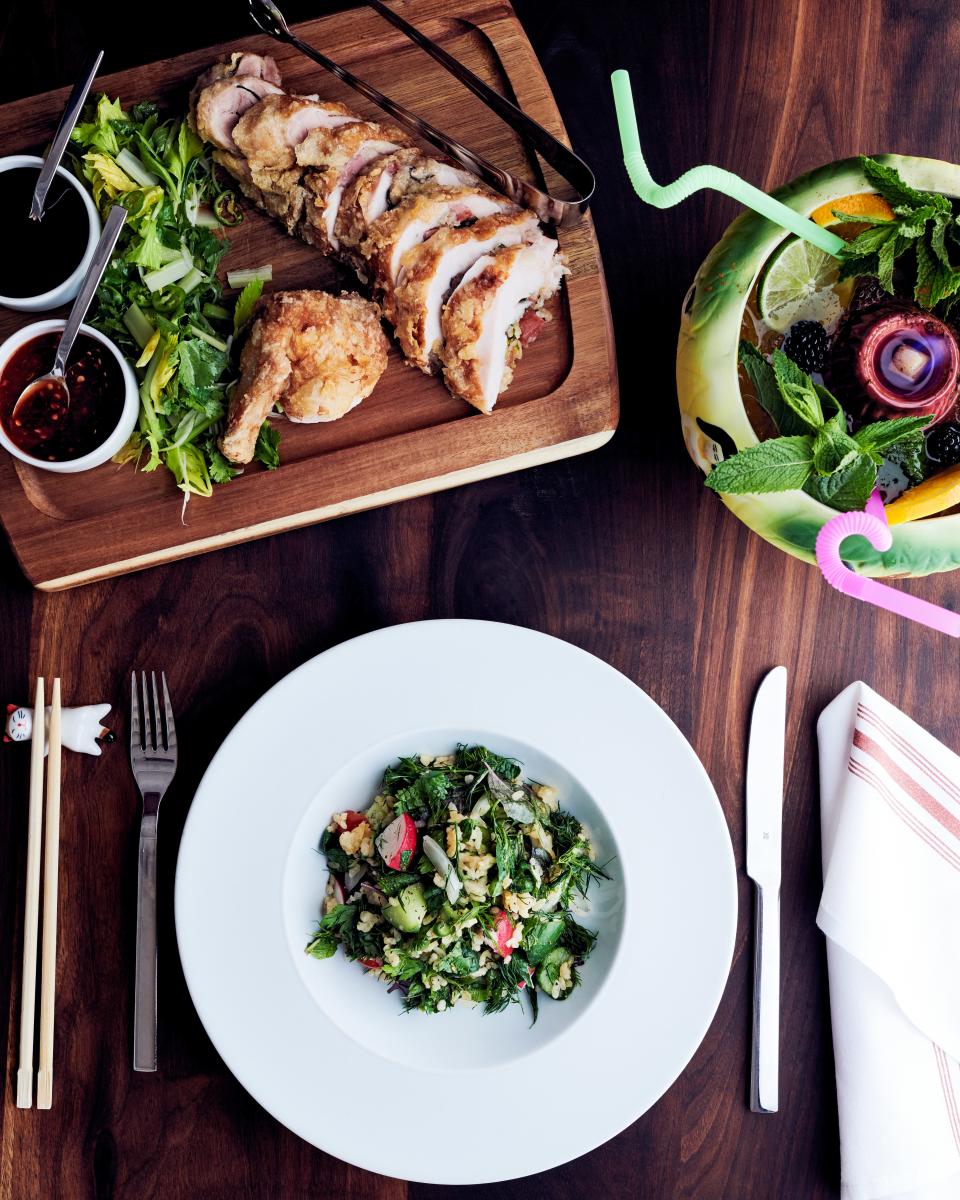
Chef Chris Shepherd turned his James Beard Award–winning restaurant Underbelly into UB Preserv, a shrine to Houston's multicultural cuisine.
Larry McMurtry once argued that Texas's cities inevitably sit uneasily alongside its rural, pioneer history: “Imagine yourself as a small hopeful immigrant family, alone on the Staked Plains, with the Comanche and the Kiowa still on the loose.… Elements of that primal venturing will surely inform several generations.” To which I would add only that you can equally imagine yourself as a small hopeful immigrant family off a plane from Saigon, or Michoacán, or Tegucigalpa, or off a bus from flooded New Orleans, in order to understand the feeling of primal venturing that Houston still exudes. And that you can look east, as well as west, for its source, to the special properties of places that line the Gulf of Mexico: Cajun self-reliance, New Orleanian devil-may-care, that sense of extraterritoriality that exists up and down America's third and wildest coast, wherever the water regularly threatens to rise. The Houston band the Suffers, which have been gaining a national profile, have a name for their smoothly powerful mishmash of ska, R&B, country, and more, borrowed from the great Beaumont-raised blues guitarist Barbara Lynn. It works equally as a description of the city as a whole. They call it Gulf Coast Soul.
As for Houston's place in the Texas firmament, one businessman with shops in all three of the state's most famous cities broke them down for me thusly: “Austin is like your young, hip millennial brother who always knows the latest cool thing. Dallas is the metrosexual middle brother that nobody really wants to spend time with. But Houston is the older, cooler sibling—he's got some miles on him, he's been through some stuff, but he totally knows what's cool and what's not.
“You love all your siblings, but you know which one you want to hang out with.”
There's a T-shirt for sale in Houston these days that was designed by James Glassman, who runs a website about the city's history and is the author of The Houstorian Dictionary. It is in the same font as KEEP AUSTIN WEIRD but one significant word shorter. It reads KEEP AUSTIN.
And anyway, you want weird? Houston has it by the square mile. Not Weird™, either. Like, genuinely strange.
The only hotel in Houston's Montrose neighborhood is La Colombe d'Or, a five-room outfit located in a mansion originally built for an oil magnate. Seemingly preserved sometime in 1979, it is filled with art and staffed by a rotating assemblage of men in suits, all of whom seem to have worked there for decades. I was the sole guest for much of my time there, in a suite that inexplicably included a full dining room set, and I was never 100 percent sure they weren't ghosts.
Montrose is the part of Houston that looks the most like a cool city is supposed to look—dense; green; filled with museums, coffee shops, cocktail bars, and other hip independent businesses; at least plausibly walkable (though few seem to do so). Montrose has also been the center of Houston's food scene, which, as is customary these days, has led the city's charge into the national conversation in a way that a music or art scene might have done for an emerging city 20 years ago.
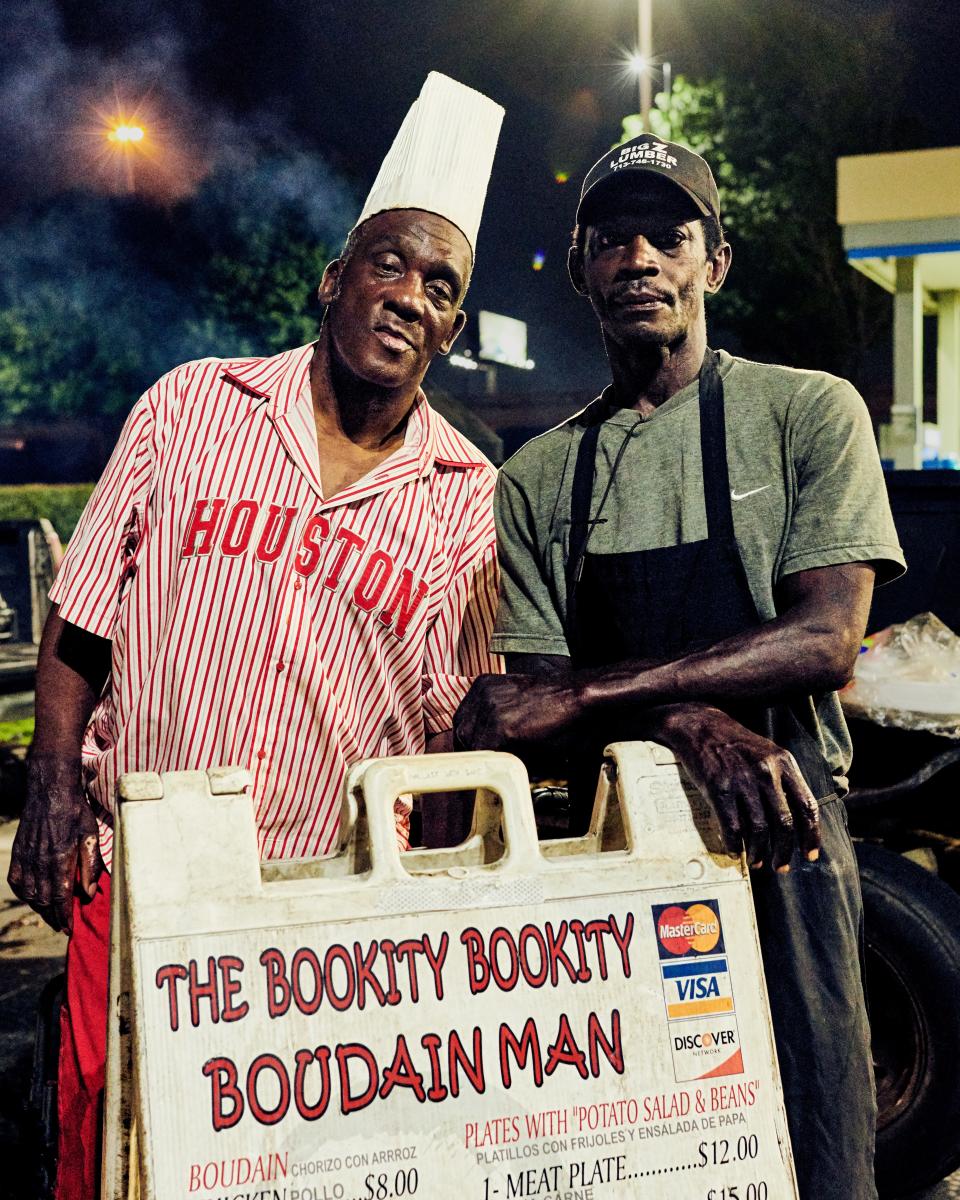
The Bookity Bookity Boudain Man is the king of Houston's pirate barbecuers, who set up shop anywhere–in his case, a Walmart parking lot.
Nobody has worked harder toward that end than Chris Shepherd, who has three restaurants in Montrose. His empire begins along Westheimer Road, Montrose's main drag, in the building that was once his flagship, Underbelly, and reopens this month as a cast-iron steak house, Georgia James. That menu (you may want to take notes) began as a one-year experiment at One Fifth, down the street, which Shepherd has given a conceptual overhaul for each year of his five-year lease. (This fall's iteration, the third, is “Mediterranean.”) Meanwhile, the much loved Underbelly, at which Shepherd won a James Beard Award, has been rebranded as UB Preserv, located in a strip mall that also houses a laundromat, a vape shop, and a clothing store called Guyz 'N' Style (“Where endless fashion meets”).
Shepherd is a large man, partial to shorts, bespoke dress shirts from the venerable Houston tailor Hamilton Shirts, and New Balance sneakers. These conceal the results of monthly pedicures finished with nail polish in the shade Deep Steel Blue, which happens to be the Houston Texans' color. Born in Nebraska, raised in Tulsa, he came to Houston for culinary school when he was 22 and has never left. “I fell in love with the city,” he says. “Everything I could ever want was here.” On days off, he would drive aimlessly and explore, reasoning that however lost he got, he could always drive straight in any direction to eventually reach the I-610 Loop that would get him home. When he found something he thought was delicious, he was unabashed about asking how it was made, ultimately transferring that knowledge to the menu at Underbelly, to which Shepherd gave the tagline “The Story of Houston Food.”
“I wanted to introduce Houstonians to their city,” he says.
One hot morning, he was doing the same for me. Despite having made this trip hundreds of times, he grew palpably excited as we approached Bellaire Boulevard, the main drag of Houston's Chinatown. Each strip mall offered another suddenly mandatory stop: hand-pulled noodles here, Szechuan dumplings there.
The most obvious urban counterpart to Houston is Los Angeles, with its diversity, its car-centrism, its sprawl. Houston is not beautiful like L.A., but it is ugly like it: We drove mile after flat mile filled with parking lots and strip malls, fast-food restaurants and box stores, new undistinguished construction cheek by jowl with older undistinguished construction. It is empirically ugly and totally intoxicating. The point isn't that there are beautiful places hidden amid the ugliness; it's that the ugliness itself becomes imbued with a kind of beauty, thanks to the thrum of human energy that takes root there. The tall multi-paneled signs standing outside each mall, written in Vietnamese, Chinese, English, Spanish, Korean, and more, begin to look like slabs of Rosetta stone. You pass buildings of exquisite strangeness. Cars mounted on poles as 3-D signs. A three-storied Italianate villa—complete with arches, columns, fountains, and statuary lining its circular driveway—turns out not to be a casino or banquet hall but in fact a dentist's office.

Shepherd and I started at Saigon Pagolac, one of the first Vietnamese restaurants to open as the city's Asian-immigrant community spread out along Bellaire in the late 1980s. Within a few minutes, the table was overwhelmed by platters of food: the crispy pancake banh xeo; tight pouches of beef wrapped in betel leaf; spongy squares of banh hoi, the intricately woven pads of vermicelli noodles. Shepherd had recently found a nearby supplier of fresh banh hoi for his own restaurant, a discovery he talked about as though each weekly delivery arrived via reindeer-pulled sleigh.
We were joined by Alba Huerta, who came to Houston from Mexico with her family when she was 6 and has long been one of the city's pre-eminent bartenders. In addition to co-owning downtown's mezcalería The Pastry War, she owns Julep Bar, which is devoted to southern cocktails and features a Jacuzzi-size tub of crushed ice behind the bar, a copper fairy rising from its center.
We talked, as we ate, about the emergence of the city's food scene. The turning point, they agreed, was the annus mirabilis of 2012. Shepherd opened Underbelly that year. Huerta was bartending at Bobby Huegel's Anvil Bar & Refuge, which had opened a few years earlier and was riding the new craft-cocktail wave. One of its founders, Morgan Weber, had just opened the gourmet Revival Market. A branch of the high-end sushi restaurant Uchi arrived from Austin. A few years earlier, Justin Yu and Seth Siegel-Gardner, both Houston-born chefs who had been working in fine dining in California and Europe, returned to town and, along with Terrence Gallivan, opened a one-month summer pop-up. It was such a resounding success that they were now opening ambitious projects in town: Siegel-Gardner and Gallivan opened The Pass and Provisions; Yu created a tasting-menu restaurant named Oxheart where he, too, won a James Beard Award.
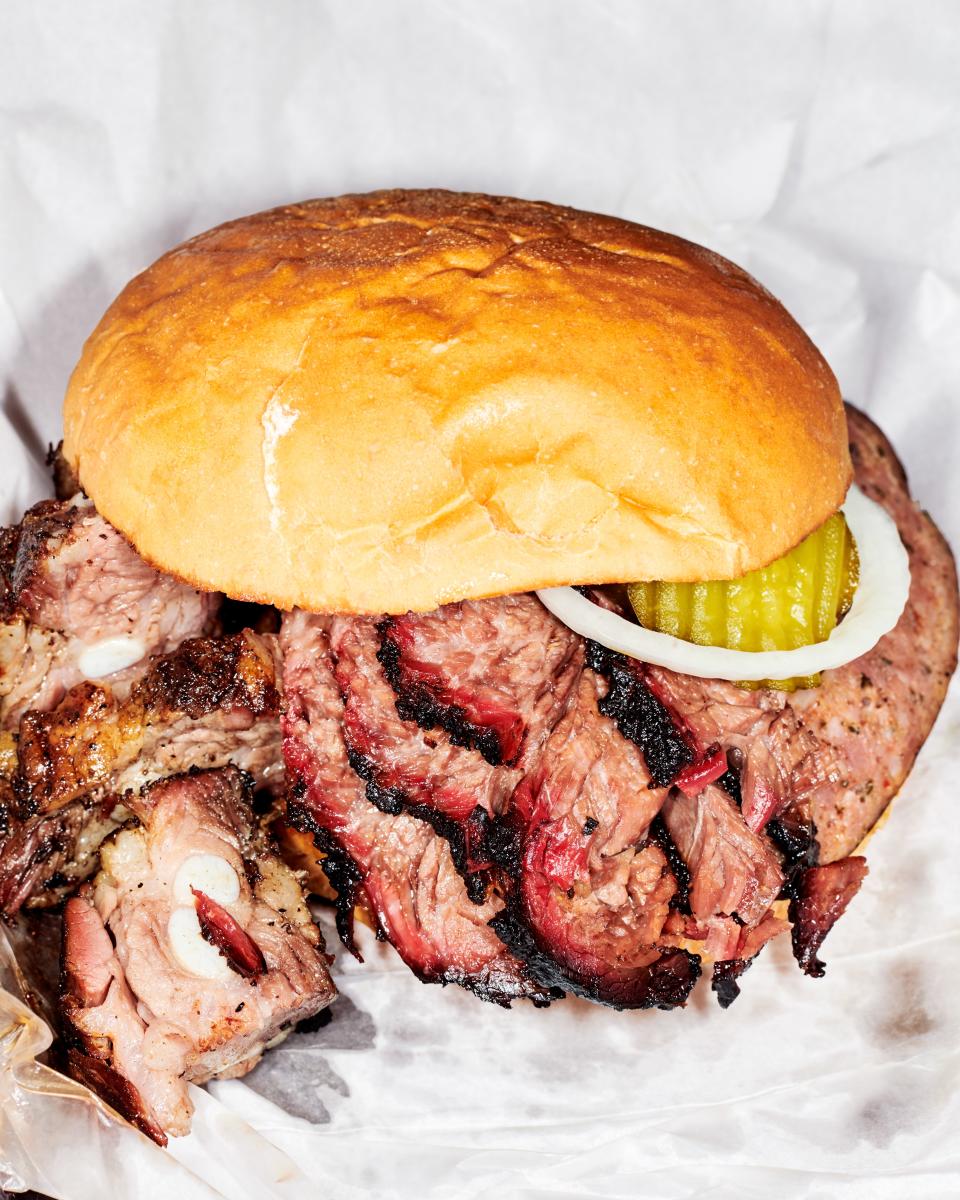
Get some at Ray's. And don't forget to order the oxtails, too.
A scene was being born—one that, its participants quickly realized, had the potential to invent a culinary identity where there hadn't been one before.
That generation has continued to work together, in various combinations, ever since. And all seem to have reached a natural point of change: Yu recently transformed Oxheart into the less rigid Theodore Rex (another 2018 GQ Best New Restaurant); Revival Market has transitioned into a fast-service restaurant; Huerta is at work on a smaller, fancier bar inside Julep; and Shepherd turned Underbelly into UB Preserv.
Stuffed already, Shepherd and I headed onward for a few pounds of Vietnamese crawfish from Mike's Seafood, a place that one of his cooks had given him a tip about. It was late in the season, making the crawfish shells hard to peel, but the citrus, garlic, and butter in which they bathed made it worth the struggle. As we left, Shepherd noticed a sign a few doors down for a Nigerian grocery store named DD Vantage. There are more Nigerians in Houston than almost anywhere else in the country, and Shepherd had been anxious to learn more about their cuisine, with an eye toward adding it to the mix at UB Preserv. We walked in, surprising a woman named Nora, who was working the cash register. Shepherd walked up and down the aisles, asking questions: Which bottle of blood-red palm oil was best? What were the fermented beans for?
“Are you with the FBI?” Nora asked.
“I'm a chef,” Shepherd said.
“Oh Lord,” Nora said, shaking her head. “When you're a chef, you get to just play around and call it food.”
Shepherd wrote down his number, inviting Nora to come to UB Preserv. He left with a heavy bag of supplies and a promise to bring some of his cooks back to ask more questions.
To many, this scene might as well be the Zapruder film of cultural appropriation. Shepherd has heard the critique, but it seems to genuinely baffle him. His mission, he says, has always been to introduce diners to cuisines they might start out too intimidated by or unaware of to explore on their own and then send them to experience the real thing. “I want to be the gateway drug,” he says. At Underbelly, and now at UB Preserv, the check comes with a pamphlet listing Shepherd's favorite restaurants, suppliers, and other businesses, including those that inspired his menu. “We'd love to have you back at UB Preserv,” it reads, “but we politely request you visit at least one of these folks first.”
The menu, overseen by chef de cuisine Nick Wong, an alumnus of Momofuku Ssäm Bar in New York, ranges liberally and lustily among the city's influences. Many of the dishes wear their inspiration on their sleeve: Beef carpaccio dabbed with an aioli made with cinnamon, star anise, and other spices and covered in Vietnamese herbs is something like a pho minus the broth. Turkey-neck yakamein is a direct hat tip to New Orleans's own Creole-Asian noodle soup. Is there something slightly absurd about lumping all of these traditions together? There is. Though it should be pointed out that Shepherd did the same with western cuisines at One Fifth, with the theme “Romance Languages,” presumed to encompass French, Spanish, and Italian. Does it always work? It does not. Is it usually delicious? Very. I found myself wrapping bits of Mexican al pastor in the lettuce leaf from Thai pork larb and dragging it through the dank, buttery garlic sauce from Shepherd's riff on Vietnamese crawfish, which have become synonymous with the deliciousness dividend of cross-cultural pollination. I thought of it as my own edible version of Gulf Coast Soul.
Of course, calling a city cool is tricky business. Cool how? Cool for who? Cool isn't the same as hipster, and it's certainly not the same as gentrified, though both seem to fix to it like remoras to a shark. And Houston didn't suddenly become cool just because outsiders started to take notice. It was cool way back when Archie Bell and the Drells name-checked it while teaching America the “Tighten Up,” cool when Montrose was perhaps the most bohemian and LGBT-friendly neighborhood in the whole South.
It was cool, certainly, when a brand of slowed-down hip-hop emerged from the streets in the early 1990s. Nobody is better evidence of that enduring cool than Bun B. As one half of UGK, he had helped translate that sound, pioneered by the legendary mixtape-maker DJ Screw in imitation of the dreamy, slurry rhythms of codeine syrup, into the sound of Houston rap. Since the death of his partner, Pimp C, in 2007, Bun B has emerged as one of the city's most visible boosters, mingling equally with politicians, millionaires, and younger hip-hop acts. He also still performs and, with his wife, produces an exceptionally funny YouTube series of cooking videos called “Trill Meals.”
“I think Bun could be elected mayor,” I was told by Shepherd, who once had him collaborate on a comic-book version of tasting notes for the wine list at Underbelly.
I met Bun B at his barber, on the southwest side of the city. It had been a typical Houston arrival in that I was convinced, pulling up to what seemed like an abandoned office complex, that my GPS had failed. Eventually I noticed a tiny barber-pole sign on one entrance. Inside, the rapper, who was born Bernard Freeman, was being tended to by Nicholas Howard, self-styled Barber to the Stars, a title bolstered by photos of athlete and rapper clients covering the wall behind his shop's single chair. Bun B shrugged when I repeated Shepherd's comment, sending the faintest ripple of alarm across the face of Howard, who happened to be holding a razor millimeters from Bun B's nose. “That might be overstating it, but I'll take it, I guess,” Bun B said. “I try to represent the city with pride.” Howard recovered and proceeded cutting his client's beard in a line as straight as a West Texas road.
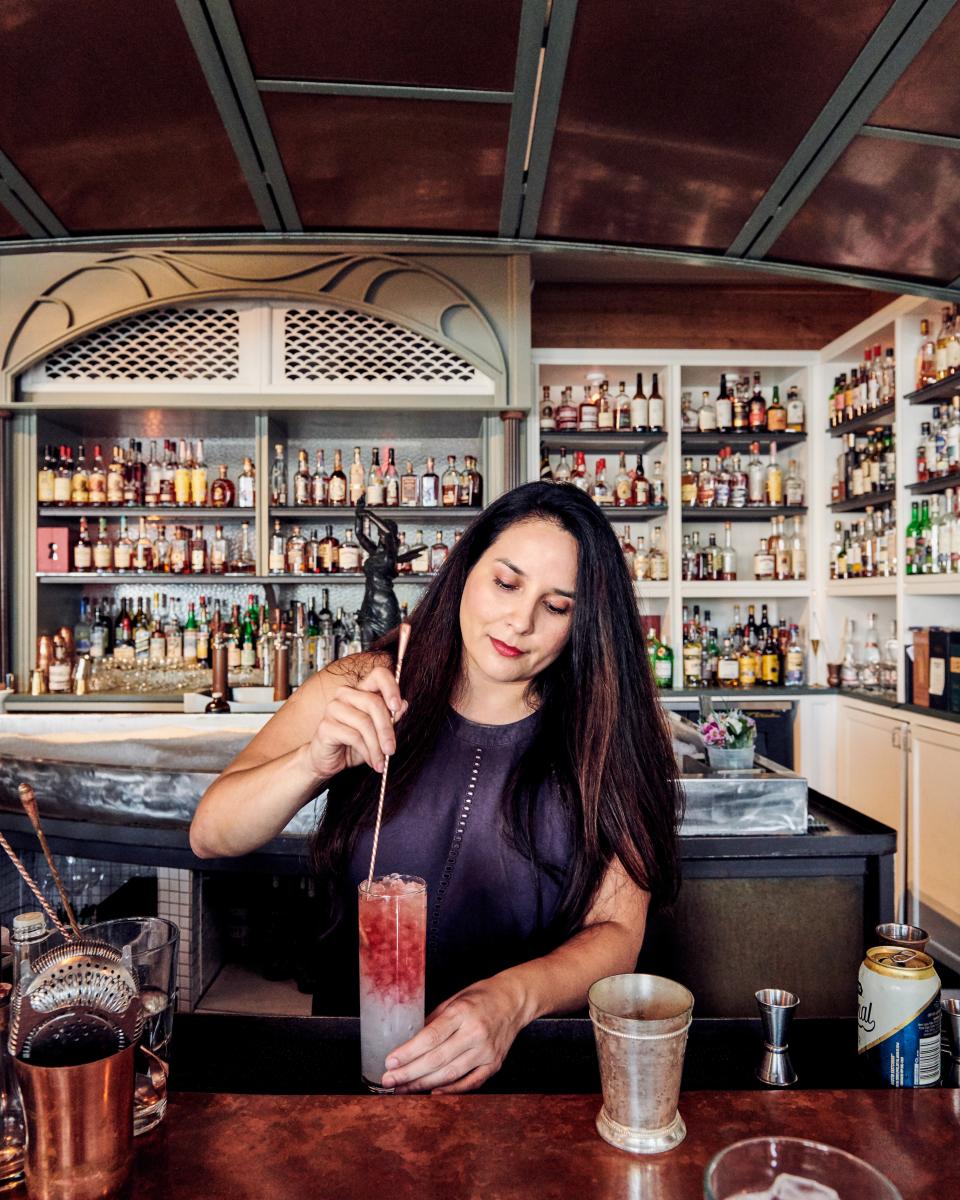
Alba Huerta at Julep, her Montrose bar devoted to southern cocktails and featuring a Jacuzzi-size tub of crushed ice.
As Bun B told it, the rise of Houston rap was another example of the city's frontier ethos. “Everybody who got famous here did it working outside the system,” he said. “It was a lot of hand-to-hand: going out, meeting people, making connections. If they had a buzz, they were the ones who created that buzz.” The success of UGK, Geto Boys, and others drove the mainstream record business crazy, he said: “New York likes to lay claim to everything, and this was something they couldn't lay claim to.” Perhaps as a sign of middle age and new civic responsibility, he now downplays the role of syrup in creating the Houston sound: “It was just a reflection of the vibe. Very laid-back.”
Another thing we tend to mean when we say a place has gotten cool is “cool for white people.” The sheer size and centerlessness of Houston has spared it some of the gentrification debates that roil other cities, but it is hardly immune. Close to downtown, the Third Ward, a traditionally African-American neighborhood that's recently seen a glut of high-priced construction, has become a particular battleground and inspired a pushback.
“White communities have their coffee shops and their bars and that kind of thing. Black communities are starting more and more to invest in themselves,” Bun B said. “It's a conscious effort to bring black businesses into black neighborhoods. It's just part of our DIY nature.”
Black Restaurant Week started in Houston in 2016 and has since spread to five other cities. The restaurant Kitchen 713 has been one participant in the promotion, serving “Global Soul” food from its location near Rice University. Another is Turkey Leg Hut, a wildly successful late-night restaurant owned by the couple Lynn and Kia Price. Music was already pounding at noon, when I sat at the bar. Behind it hangs a yellow neon sign: WHEN LIFE GIVES YOU LEMONADE, ADD HENNESSY. That apparently goes equally for when life gives you turkey legs. The Hut's signature item is a tomahawk-size leg, smoked until ruby red and ready to fall apart at the slightest touch; one version comes lacquered with a sweet, slightly spicy Hennessy glaze. (There is also a Cîroc Mango Habanero version that I felt would be too performatively woke to order.) The legs are also available stuffed with shrimp Alfredo or crawfish mac and cheese. If that sounds vulgar, consider that it is reminiscent of nothing so much as the signature dish of Montreal chef Martin Picard, who stuffs a slow-cooked pig's trotter with foie gras at his restaurant Au Pied de Cochon and in return receives endless accolades, not to mention 60 Canadian dollars.
The frontier comes in different guises: Sometimes it looks like a pickup truck barreling up I-45 at night, bouncing behind it the blackened tube of a smoker at full burn, smoke billowing down the road like steam from a locomotive. This is the Bookity Bookity Boudain Man, king of Houston's pirate barbecuers, whose destination is a Walmart parking lot somewhere north of the Loop, I-610, south of the beltway, TX-8.
I am being vague because, as Bookity tells me, he's “down with the underground economy,” a position that somehow doesn't preclude taking credit cards or having a Facebook page but that has a well-established history in Houston. “We have a long tradition of ‘shade tree’ barbecue,” said J. C. Reid, who co-founded and runs the Houston BBQ Festival and writes a barbecue column for the Chronicle. “Somebody just sets up under a tree and starts cooking. It's old wildcatter culture.”
Bookity wears a chef's toque and a T-shirt covered in hundred-dollar bills and the word HUSTLE. He lost his left foot to diabetes last year, so he's in a wheelchair, and while a younger employee works the smoker, he works the crowd. A steady stream of cars and SUVs, driven by whites, African-Americans, Latinos, and Asians, head off into the night with fat, ricey links of boudin sausage; slabs of ribs; pork-shoulder steaks pulled, sizzling, off of the smoker's burn box; and dripping, moist links of deer sausage made from deer that a couple of police-officer customers who are also hunters bring him. “That's wild meat,” he said. “Not everybody can stand the wild.”
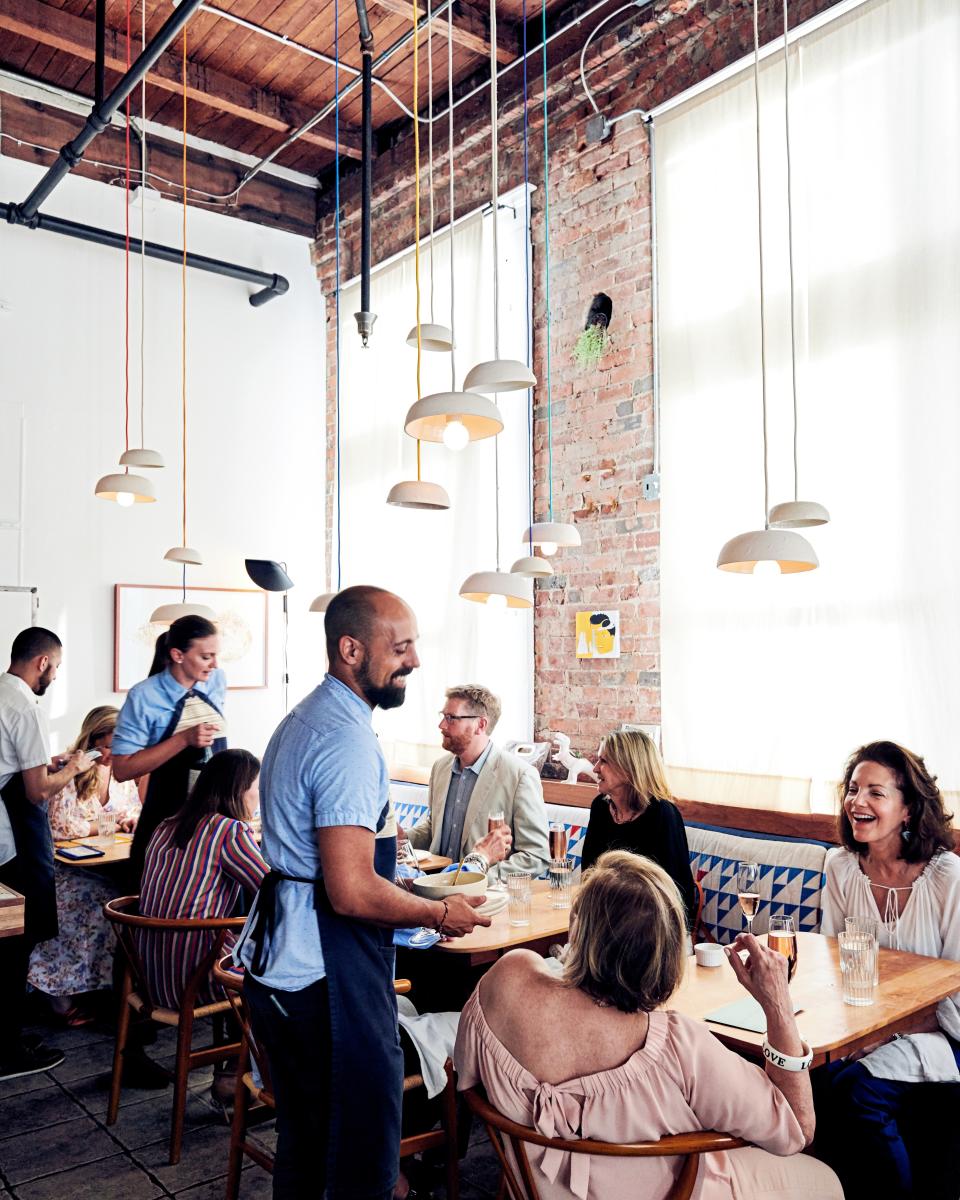
The light-filled—and extra-delicious—environs of Justin Yu's Theodore Rex, a GQ Best New Restaurant of 2018.
Sometimes the frontier looks like The Orange Show, an extraordinary artifact of outsider art in the East End, built over the course of several decades by an eccentric postal carrier named Jeff McKissack. McKissack was obsessed with the healthful properties of oranges and constructed a riotous, colorful shrine filled with twirling weather vanes, welded birds, fluttering Texas flags, and cryptic mosaic proclamations from Confucius, Aesop, and others. McKissack reportedly felt a keen sense of competition with another monument to human insanity and hubris going up across town: the Houston Astrodome. It pleases me on his behalf to note that the Dome closed its doors over a decade ago while The Orange Show is still open for visitors, administered by a foundation that also oversees a collection of mosaics just down the street named Smither Park, and the annual Houston Art Car Parade.
“There's a wonderful quirkiness that has a home in Houston,” said Rebecca Rabinow, the director of the Menil Collection. Named for John and Dominique de Menil, visionary activists and collectors who moved to Houston from France during World War II, the Menil is one of the world's great museum-going experiences: Its campus of bungalows and galleries seems to grow organically out of the surrounding Montrose area. Its main lawn has become a kind of public square for picnickers, yoga groups, hippies doing circus tricks, and those just napping under the live oaks. It is also the anchor of a museum district rich with the benefits of the kind of institutional philanthropic art funding that comes with periodic oil booms. The Houston Center for Photography is nearby, as is the Contemporary Arts Museum Houston, the Museum of Fine Art, and, most indispensably, Rothko Chapel, the artist's last commission and a place (to me, at least; part of its power is that it means different things to different people) of simultaneous melancholy and soothing.

Rabinow took me on a tour of the museum's newest building, the Menil Drawing Institute, proof that sometimes the frontier can come in the guise of the old-fashioned institutional high culture as well. The $40 million building, by the firm Johnston Marklee, is stark white, with overhangs that echo Renzo Piano's main Menil Building as they extend out into the surrounding area and crisp, folding angles that bring to mind the works on paper it is built to celebrate. We walked through bright, empty galleries, archives, and research rooms as workmen moved past us, attending to finishing touches. Given the fragile nature of paper, the building would be brought to optimal temperature and humidity for six weeks before any art was introduced. That was not the only consideration being made for climate: At key doorways, Rabinow pointed out, there were riveted cuts in the floor, like those on the deck of a boat. These were dams, programmed to automatically rise if water ever breached the already formidable network of pumps and bulwarks designed to protect the collection against the intrusion of weather. Harvey had been an unexpected test, and the dams had not even been called into use.
Rabinow spent nearly 30 years as a curator of modern and contemporary art at the Metropolitan Museum of Art in New York before returning to Houston, where she'd spent her high school years. “I came for the Menil, but Houston has been the real surprise,” she said. “There's a sense of percolation in the arts that's very palpable. You have a creative class that can afford to be here and an innate sense of confidence that you can try anything. It might work, it might not, but people are going to show up.”
These qualities—community and affordability—shouldn't be underestimated. They're part of what allowed someone like Chris Wise to stay in the city. Wise, 31, is the talent booker for the Day for Night music-and-arts festival (which was headlined last year by Nine Inch Nails and took place in a converted post office), a part-time bartender, and the bassist for the neo-Americana band Buxton. He grew up in La Porte, a town 30 minutes east of Houston dominated by petrochemical plants that nearly every high schooler was expected to go work for after graduation. As a kid more interested in film, musical theater, and art, Wise had other plans, but unlike those of previous generations, that didn't automatically mean heading east or west. “New York or L.A. never really occurred to me,” he said. Instead, he set up in Houston, where energy may rule the roost (nearly every person I met could quote the current price for a barrel of crude oil off the top of their head), but there's still room for a young man to pursue talent booking/bass playing/bartending while living with two dogs in a one-bedroom apartment near downtown for $600 a month.
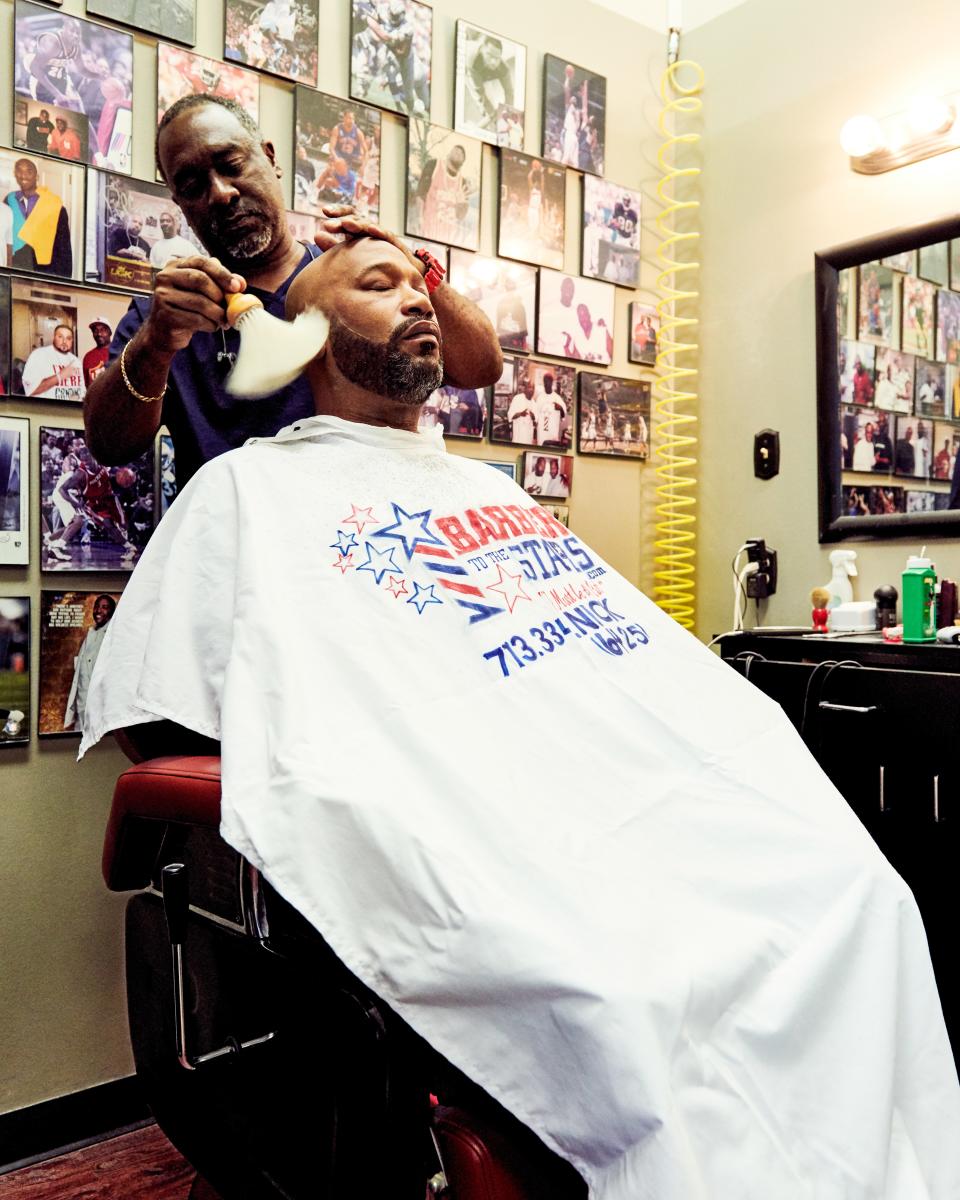
Rapper Bun B—one of Houston's best ambassadors—gets his hair cut by Nicholas Howard, self-styled Barber to the Stars.
Handsome and slender, with a sweep of hair in something approaching a pompadour, Wise appears to know literally every person in town, a condition that grew so comically ostentatious during an evening bar crawl that he felt the need to embarrassedly assure me that he hadn't set up any of our encounters. Echoing many others I'd met, he said that technology has helped Houston's scene cohere. Until recently, it was simply hard to navigate the far-flung corners of the city, much less gather a crowd. “There was always great food, but it was 30 miles away,” he said. “There were people who wanted to come see shows, but they didn't want to drive.” Now social networks have brought people of similar interests together; Google Maps help them find places to meet; ride shares let them stay out later getting drunk and then home safe. If there's anything left in the exposed wreckage of tech utopianism, this is it: The damn phones really do help people find one another.
And, yes, sometimes the frontier looks like Hipster Brigadoon, as in the sprawling compound of a bar in midtown called Axelrad Beer Garden. In the center of the outdoor space is a large tree covered in neon. Around that totem, when Wise and I visited, was arrayed an entire souk: There was an Airstream outfitted with beer taps. Massage tables. Shelves filled with board games. Someone was selling churros from a folding table. At another, a South Asian man offered biryanis. Couples wound their way through, carrying steaming boxes from the adjacent pizzeria. Along one long side, there was a grove of hammocks hanging from steel racks and swaying in the summer breeze, each as heavy as a seed pod with a young, beautiful body, sometimes two; if you ever find yourself asking “Where did all these hipsters come from?” look to the fertile Hammock Fields of East Texas.
One of Axelrad's owners, Adam Brackman, cut his teeth helping out and providing a venue for displaced New Orleans musicians after Hurricane Katrina. The NOLA trumpeter Kermit Ruffins is an Axelrad investor and plays regular gigs there. (Some 250,000 New Orleanians spent time in Houston after that storm; an estimated 40,000 stayed for good—a small population bump but one that can't have had anything but a happy effect on Houston's taste for eating, drinking, and going out.)
It was open-mic night, and on a large stage near the neon tree, a bearded guy with a guitar sang “Ain't No Sunshine” while surf videos played on the wall behind him. He was followed by a young black duo. He, with dreads creeping out from under a bucket hat, started rapping in a kind of mumble while she crooned Fill me up / Fill me up / You've got to fill me up in a way that made it clear she didn't mean with gratitude. The performance threatened to wander off course until the “Ain't No Sunshine” guy reappeared, strumming, behind them, and suddenly it all came together.
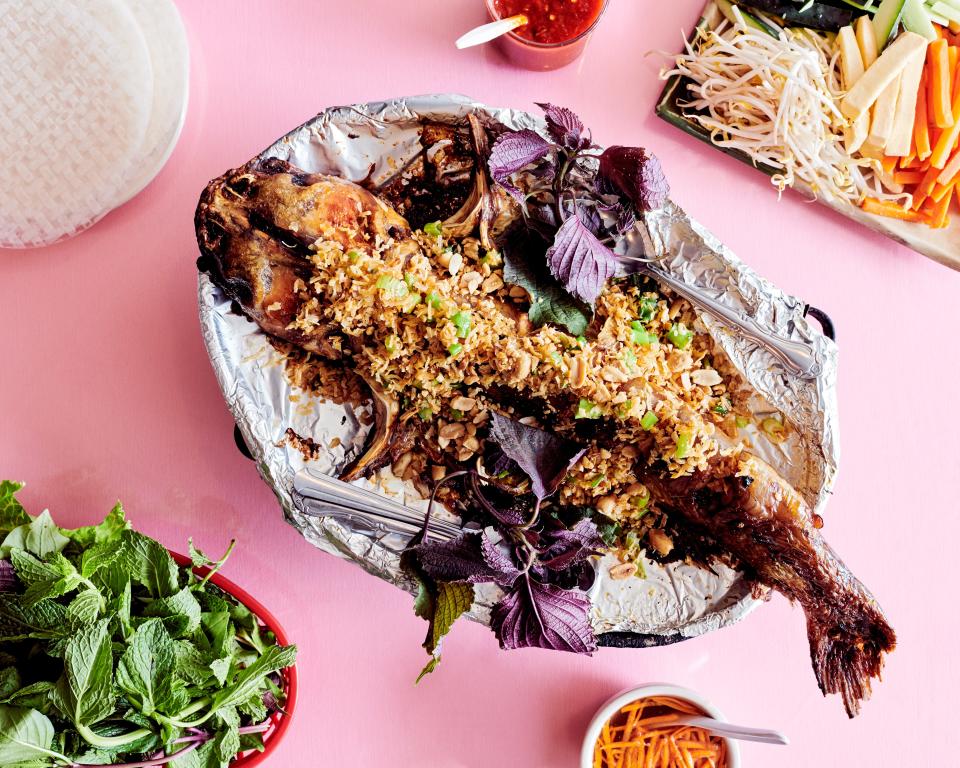
The bounty at Saigon Pagolac, one of the first Vietnamese restaurants to take root along Bellaire Boulevard in the late 1980s.
It was hard not to think of the Suffers' “Gulf Coast Soul” and of Kam Franklin, the band's mighty-voiced lead singer. Raised in Houston, Franklin got her first gigs by inventing agents and managers: fake old white guys with fake e-mail accounts.
“I used ‘Mike’ a lot. Mike seems like a trusty guy but also tough,” she said.
In those days, Franklin could easily have borrowed the Bookity Bookity Boudain Man's HUSTLE T-shirt: Wednesdays and Thursdays, she sang at open mics at R&B clubs on Almeda Road or Emancipation Avenue, joints where you needed to crush covers of Erykah Badu or Chaka Khan or Beyoncé 50 or 60 times with the house band before anybody even thought of asking about original material. “Late Tuesdays, I'd go sing with a country band I used to mess around with,” she said. “Saturdays, I'd go hang with the punk and ska kids. And the rest of the week it would be studio gigs with rappers, if I could get them.”
On the road, people still express disbelief that the band is from Houston. “We get, ‘Are y'all from Austin? Are y'all from New Orleans?’ I'm like, ‘No, we're from H-Town, Texas. Where we're going to stay.’ ”
The Suffers' new album, Everything Here, leads off with a song called “Intro (A Headnod to Houston).” It features Paul Wall rapping over a background of voices singing: It might not be that pretty / But it looks real good to me / It might not be your favorite city / But it's really got a hold on me.
Maybe it's that sense of defiance that ultimately defines Houston's cool—the sense that a city where cool isn't the primary commodity can afford to lie back and let the world come to it, whenever the world catches on. As Matthew Odam's passenger put it, before closing the car door and taking off toward the Menil's lawn and into legend: “Houston is cool because Houston doesn't give a fuck about being cool.”
Brett Martin is a GQ correspondent.
This story originally appeared in the September 2018 issue with the title "The New Capital of Southern Cool."

